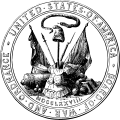The Department of the Pacific or Pacific Department was a major command (Department) of the United States Army from 1853 to 1858. It replaced the Pacific Division, and was itself replaced by the Department of California and the Department of Oregon.

John Irvin Gregg was a career U.S. Army officer. He fought in the Mexican–American War and during the American Civil War as a colonel and near the end of the war as a brevet general in the Union army. In 1866, he was nominated and confirmed as a brevet major general of volunteers and a brevet brigadier general in the Regular Army, both to rank from March 13, 1865.

James Barnet Fry was an American soldier and prolific author of historical books.
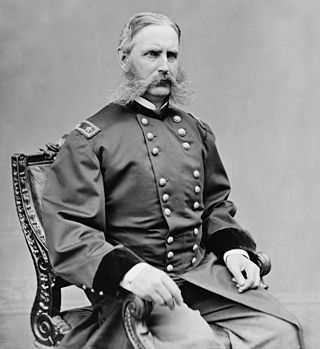
Christopher Columbus Augur was an American military officer, most noted for his role in the American Civil War. Although less well known than other Union commanders, he was nonetheless considered an able battlefield commander.

Asa Peabody Blunt was an officer in the Union Army during the American Civil War. He remained on active duty after the war. In recognition of his service during the Civil War, he was appointed to the grade of brevet brigadier general of volunteers. Blunt was notable as commander of the 2nd Vermont Brigade and the United States Disciplinary Barracks at Fort Leavenworth, Kansas.

Eli Long was a general in the Union Army during the American Civil War.

Thomas West Sherman was a United States Army officer with service during the Mexican–American War and the American Civil War. While some contemporaries mistakenly identified him as the brother of the more famous General William T. Sherman, modern scholarship notes that the two were not closely related.
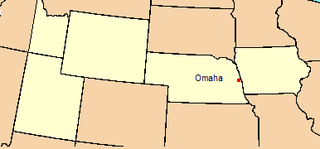
The Department of the Platte was a military administrative district established by the U.S. Army on March 5, 1866, with boundaries encompassing Iowa, Nebraska, Dakota Territory, Utah Territory and a small portion of Idaho. With headquarters in Omaha, the district commander oversaw the army's role initially along the Overland route to Salt Lake City, then later the construction route of the Union Pacific Railroad. The district also included the Montana road through eastern Wyoming. The district was discontinued when the Army's command was reorganized in 1898.
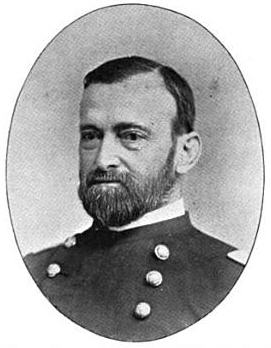
Samuel Breck was an officer in the United States Army who served as Adjutant General of the U.S. Army from 1897 to 1898.

The Department of Oregon was one of two Army Departments created September 13, 1858, replacing the original Department of the Pacific and was composed of the Territories of Washington and Oregon, except the Rogue River and Umpqua Districts, which were assigned to the Department of California. Its creation was authorized by General Orders, No. 10, of the United States Department of War, Adjutant-General's Office, September 13, 1858. Its headquarters was at Fort Vancouver, in the Washington Territory.

The Department of California was an administrative department of the United States Army. The Department was created in 1858, replacing the original Department of the Pacific, and it was ended by the reorganizations of the Henry L. Stimson Plan implemented in February 1913. As with the preceding organization, headquarters were in San Francisco. Its creation was authorized by General Orders, No. 10, of the War Department, Adjutant-General's Office, September 13, 1858.
Joseph Nelson Garland Whistler was a career United States Army officer. He served in the Mexican–American War and received a brevet appointment for distinguished service in the Battle of Contreras and the Battle of Churubusco. At the beginning of the American Civil War, Whistler was among the U.S. Regular Army officers taken prisoner by Confederates in Texas in April 1861 and paroled but was not exchanged until August 15, 1862. In 1863, he became colonel of the 2nd New York Heavy Artillery Regiment. He received a promotion and four brevet appointments in the regular army for his service during the Overland Campaign, specifically the Battle of North Anna, and the Siege of Petersburg, specifically the Second Battle of Petersburg. He was nominated on January 13, 1866 and confirmed on March 12, 1866 for appointment to the grade of brevet brigadier general of volunteers, to rank from March 13, 1866. He retired in on October 19, 1886 as colonel of the 15th U.S. Infantry Regiment.
The District of New Mexico was a military district of the United States Army in the Territory of New Mexico that existed from 1865 to 1890. The District of Arizona and the District of New Mexico replaced the Department of New Mexico from June 27, 1865.

Samuel Beckley Holabird was a career officer in the United States Army. A Union Army veteran of the American Civil War, Holabird attained the rank of brigadier general and is most notable for his service as the Army's Quartermaster General, a position he held from 1883 to 1890.
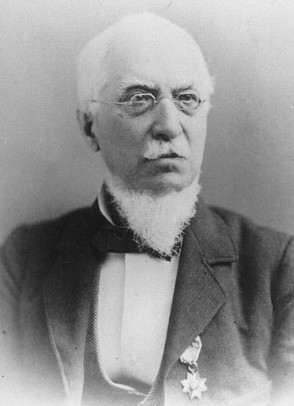
Albemarle Cady was a career United States Army officer who served in the Second Seminole War, Mexican–American War, First Sioux War and the American Civil War. During the Civil War, he was briefly lieutenant colonel of the 7th Infantry Regiment. He then served in administrative positions in the Department of the Pacific, including the District of Oregon. He received brevet appointments for his service in the Mexican–American War and the Civil War. He retired from the Regular Army as a colonel on May 18, 1864. On July 17, 1866, President Andrew Johnson nominated and on July 26, 1866, the United States Senate confirmed the appointment of Cady as a brevet brigadier general in the Regular Army, to rank from March 13, 1865.

Henry W. Closson was a career officer in the United States Army. A veteran of the American Indian Wars and the American Civil War, he served from 1854 to 1896 and attained the rank of colonel. During the Civil War, Closson received brevet promotions to major and lieutenant colonel to recognize his heroism during the Siege of Port Hudson, Louisiana and Siege of Fort Morgan, Alabama.

Charles G. Sawtelle was a career officer in the United States Army. A veteran of the American Indian Wars and American Civil War, he served from 1854 to 1897 and attained the rank of brigadier general while serving as Quartermaster General of the United States Army.

Charles Hale Morgan (1834–1875) was an American soldier who fought in the Utah Expedition and the American Civil War, rising to the rank of brigadier-general for services in the field during the Civil War.

Lawrence Sprague Babbitt was a United States Army colonel. He was the father of Edwin Burr Babbitt.
















